California state is enormous, and its terrain is remarkably diverse.
It is among the most varied states in the U.S., with landscapes ranging from hot deserts to verdant redwood forests.
That’s fantastic for ecotourists but even more so for birdwatchers since it indicates that a wide variety of owls may be found across the state.
It’s true that California is home to 14 distinct owl species.
Here are the Types of Owls in California.
| Image | Name |
|---|---|
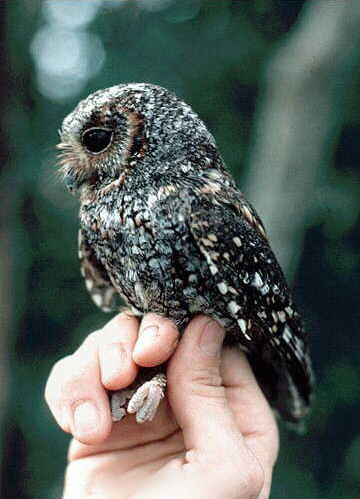 | Flammulated Owl |
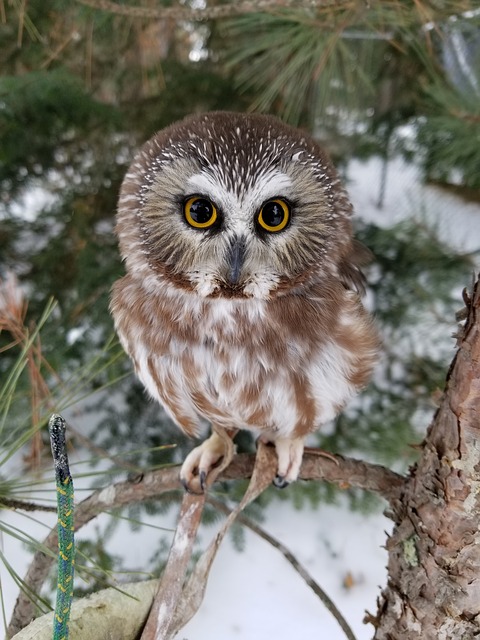 | Northern Saw-Whet Owl |
 | Snowy Owl |
 | Barn Owl |
 | Elf Owl |
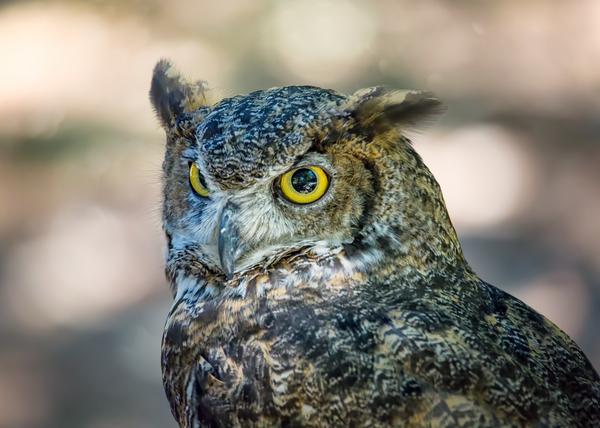 | Northern Pygmy-Owl |
 | Burrowing Owl |
 | Western-Screech Owl |
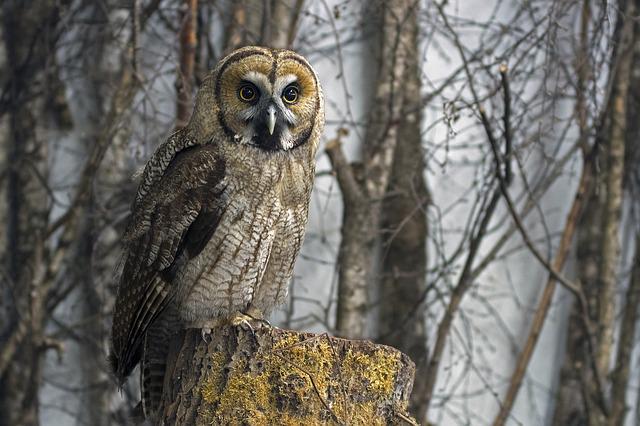 | Great Gray Owl |
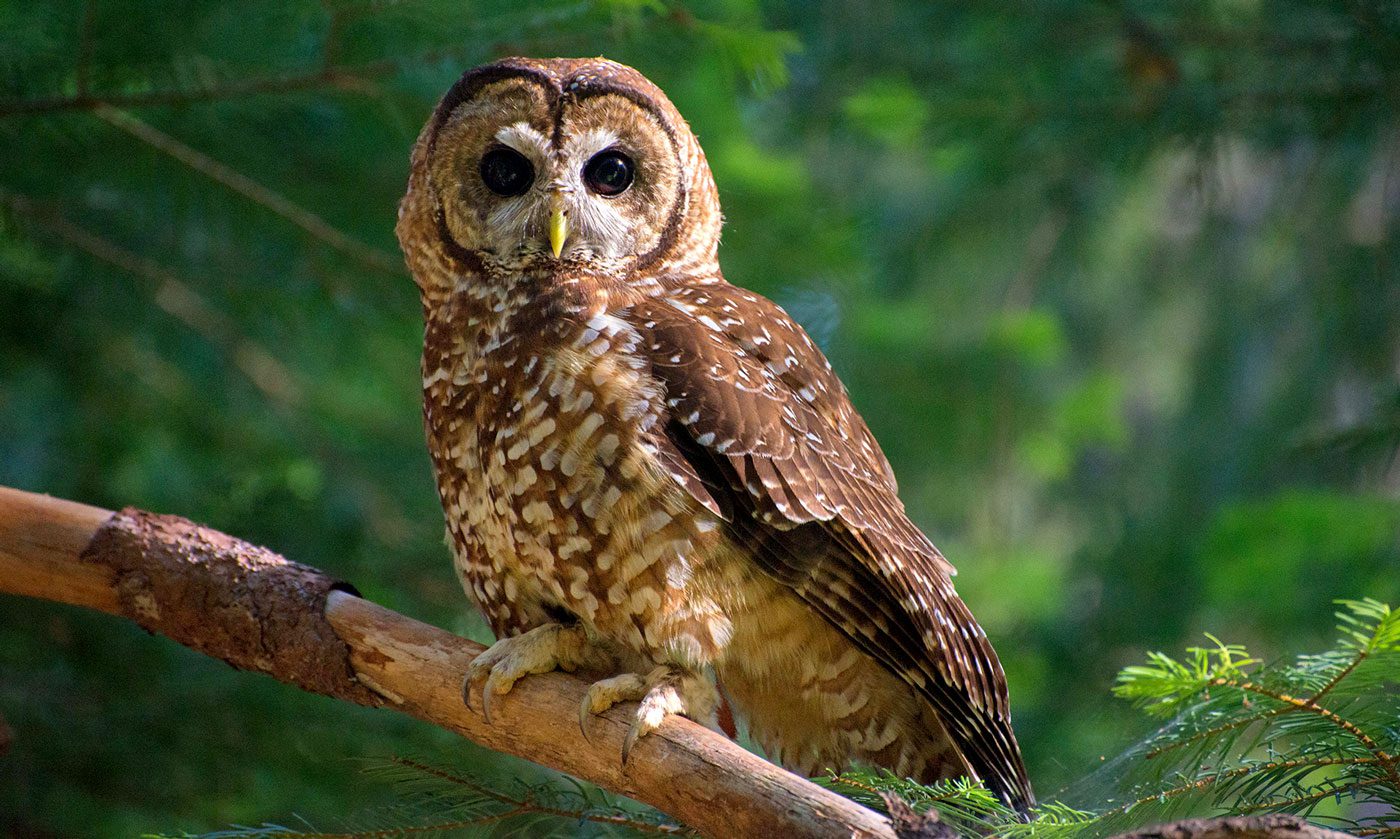 | California Spotted owl |
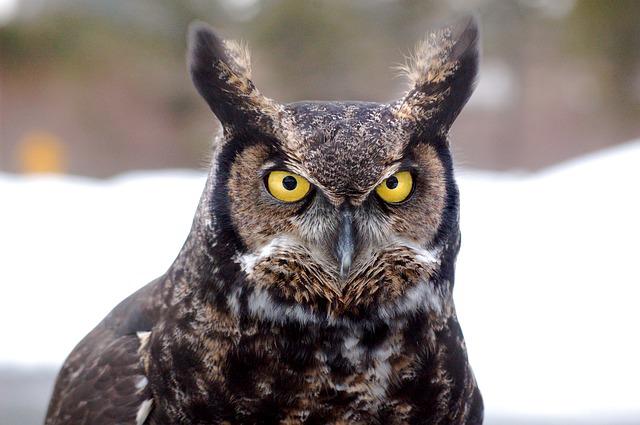 | Great Horned Owl |
 | Barred Owl |
 | Short-Eared Owl |
 | Long-eared Owl |
Types of Owls in California
1. Flammulated Owl

During the mating season, Flammulated Owls can be discovered in only a small portion of California, though they are relatively common in these areas.
Very diminutive in stature, these owls have the same general outline as the screech owl but with noticeably shorter tufts of hair atop their heads.
Their pale gray-brown feathers make it difficult to distinguish them from tree bark, making sightings of these birds unusual.
Habitat
Mature pine forests are the ideal habitat for these owls, where they can roost throughout the day and go hunting at night.
It’s usually much simpler to find them at night than during the day.
Follow their deceptively quiet hoot to find them. However, this may be difficult to accomplish because their calls sound further away than they actually are.
2. Northern Saw-Whet Owl

Throughout much of northern California, the Northern Saw-whet Owls are permanent residents.
However, their breeding range does not include some of Southern and Central California.
Habitat
These owls are small, camouflage-like in coloration, and notoriously secretive, so they are rarely seen outside of dense coniferous woodlands and groves.
Since it is so adept at sitting still and evading detection, it is often overlooked in its natural habitats. Find it by listening to its high-pitched “tooo-tooo-tooo” call.
Males will produce this call over and over again for hours during the mating season, giving you a great chance of seeing one.
Put up a nesting box for Northern Saw-whet Owls if you are a resident of California, and you’re close to the region where they breed.
It will serve as a nesting site for a pair of owls, and you’ll have a better opportunity to observe these nocturnal creatures in their natural habitat.
3. Snowy Owl

Although Snowy Owls are seldom seen in California, it is possible to see one in the far north during the winter due to irruptive migrations.
Snowy owls spend most of the year on the northern tundra and throughout Canada in the winter.
Whenever they have been seen in the state, it has been in open settings like fields.
The stunning snow-white plumage of a Snowy Owl’s huge, the spherical body sets it apart from other owls.
It’s common to see more black and dark brown spots on a female’s body than a male’s, and the reverse is also true.
The eyes of both sexes are a vibrant shade of yellow.
4. Barn Owl

In addition to their widespread distribution in North America, Barn Owls can also be found in many other regions of the world.
Habitat & Food
They can be seen in both forested and open lands throughout the state of California throughout the year long.
The term “barn owl” refers to the bird’s preference for roosting and nesting in quiet, unoccupied buildings like forgotten barns.
Most of these owls’ diets consist of rodents like voles and mice, which are abundant in agricultural areas.
At night, they sneak up on their prey by flying low to the ground in complete silence and using their acute hearing and vision to find their way.
These owls’ faces are ghostly white, and their eyes are a deep, dark color.
These owls are about the size of a crow, making them medium-sized. Their vocalizations sound more like harsh, raspy screeches than the typical hoots.
When the sun goes down, keep an ear out for their calls and your eyes scraped for a flash of white to float by.
5. Elf Owl

Southern California and Baja are home to breeding Elf Owls.
They’re about the size of a sparrow and the tiny owls in California and the world.
You can find them in California in the summer and spring, but in the winter, they head south to Mexico in search of warmer weather.
Elf Owls are easily recognized by their small stature, lack of ear tufts, which results in a round head shape, and brownish-gray feathers.
Food
They eat mostly insects and arthropods but will also take small lizards and blind snakes if they can get their hands on them.
The loss of Elf Owl habitat has led to their near extinction in California, where they are mentioned as an endangered species.
6. Northern Pygmy-Owl

Northern Pygmy-Owls can be seen year-round in a few locations throughout California, mainly in the state’s coastal and northern regions.
Because of their daytime activity, they are more easily spotted than other types of owls.
You still need to keep an eye out for them despite their diminutive size and the fact that they often sit motionless on a perch while waiting for prey.
You can find them a little less difficult if you learn to recognize their high-pitched calls and toots.
Keep an ear out for flocks of noisy birds. In an effort to drive away a Northern Pygmy-Owl, they may swarm the bird if they happen upon one.
Since Northern Pygmy-Owls eat mostly small birds, this is only fitting. It is possible that these birds, especially chickadees, will attempt to swarm a birdwatcher if they hear him or her imitating the Northern Pygmy-call.
7. Burrowing Owl

Some Burrowing Owl nesting colonies have been detected in California’s far southeast, despite being more common further south.
Moreover, Southern California is home to a sizable population of Burrowing Owls that remain there all year.
Habitat
Grasslands and prairies make up the bulk of their habitat.
Burrowing Owls, unlike other owls, construct subterranean nests out of tunnels and dens.
Their astute owls also use these subterranean dens to stockpile food for use throughout the lengthy processes of incubation and brooding.
Burrowing owls are little, roughly the size of a robin, but stockier overall.
Their round, sandy-colored heads lack ear tufts, and they have brown markings on their feathers.
These owls don’t use flight to hunt, either. On the contrary, they use their long legs to scurry about on the ground in search of insects and other tiny prey.
8. Western-Screech Owl

In most of the state of California, Western-screech Owls are perennial residents.
Owls of this species are about the size of robins, with stocky bodies and relatively brief tails.
When they are roosting in cavities during the daytime, their mostly gray-brown feathers with streaky underparts blend in remarkably well against trees.
Food
They wait for their prey to come to them at night, when everything is quiet and peaceful, before swooping down to get it.
In addition to fish, reptiles, and small birds, they will also collect insects mid-flight to boost their diet.
Western-screech owls are best found, like other nocturnal owls, by listening for their calls late at night.
In their calls, they make a series of high-pitched toots that get a little faster as they go on.
If you reside in a region where these owls are found, you might want to provide a nesting box for them in your garden.
9. Great Gray Owl

In certain regions of Northeastern California, Great Gray Owls are permanent residents.
These owls are among the largest in the Americas, with enormous bodies, wide wings, and long tails.
The big disks of their faces make their eyes look small and close together, giving them a distinct look.
Furthermore, they can be recognized by the white “X” pattern on their faces.
Their namesake fluffy gray feathers cover their entire bodies.
Habitat
These owls are reserved and somber; they don’t like the spotlight.
They avoid human settlements and instead make their homes in remote pine forests or on the outskirts of grassy fields.
As is the case with most owls, they are most active during the night when hunting, specifically in the hours just before sunset and sunrise.
10. California Spotted Owl
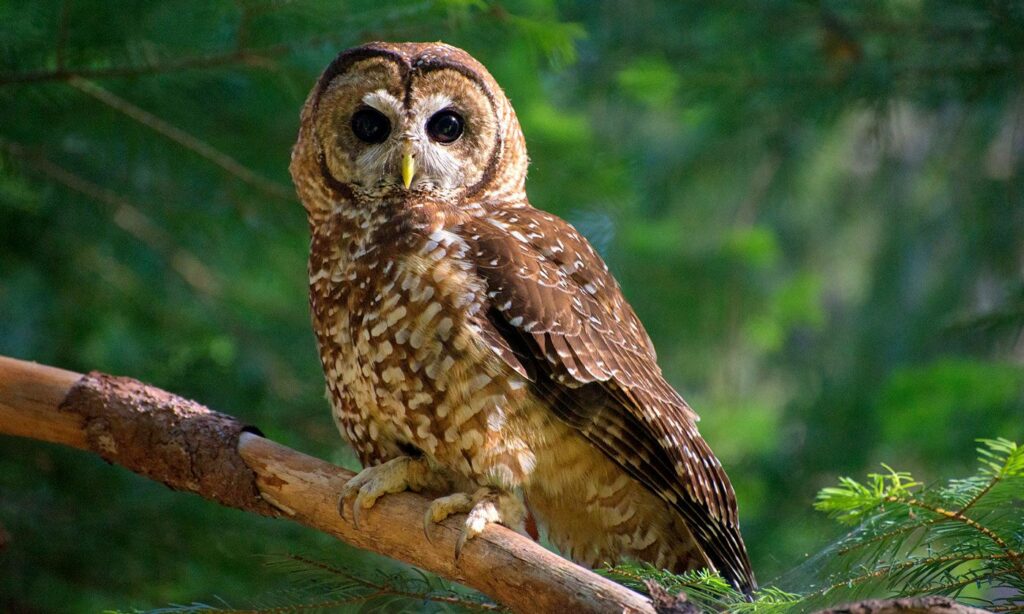
California Spotted owls are elusive and only regularly seen in a small fraction of California.
The Spotted Owl’s population has plummeted because of the destruction of its natural habitat, the old-growth forest.
Survival is harder for these owls due to competition with Barred Owls.
Even farther north in the state, Northern Seen Owls have been spotted.
Appearance
Spotted Owls, although similar in size to Barred Owls, are smaller overall and have more rounded bodies and heads.
Their plumage is generally dark brown with white spots here and there. You may recognize them by the white “X” on their face disks.
Spotted Owls, like other owls, are nocturnal hunters who specialize in catching tiny mammals.
On quiet evenings in the vicinity of woods, their booming, deep hoots may sometimes be heard for more than a mile.
11. Great Horned Owl

The Great Horned Owl is the type of owl most people picture when they think of owls.
Large, cat-like eyes, long tufts on their heads, thick, stocky bodies, and a deep, strange hoot are just some of the characteristics shared by these owls and the owls of children’s literature.
California spotted owl is a resident of the Golden State all year round and is among the most prevalent owls in all of North America.
Habitat
The Great Horned Owl is adaptable and can live in a wide range of environments, but forests with plenty of open areas are where you’ll most likely find one.
Big owls are fierce hunters that can bring down animals many times their size.
Rodents, reptiles, and even large birds like hawks and geese are all fair game for their stomachs.
The soft plumage that covers their entire bodies allows them to sneak up on their prey and dive-bomb without being heard.
12. Barred Owl

Despite their rarity, Barred Owls can be found year-round in isolated pockets of Northern California.
These owls are primarily found in the swamps of the southeastern United States.
The best places to find them in Washington State are forests and woods that are close to water.
Although they typically come out to hunt at night, you can occasionally hear them making calls or see them during the day.
Finding these owls is easier if you listen to their distinctive, rich-sounding “who cooks for you?” call rather than just looking in the trees.
The bodies of barred owls are stocky, and their heads are smooth and round.
Their pupils are large, and their eyes are so darkly brown that they almost look black.
Their entire plumage is mottled brown and white, and there are brown vertical bars on their upper parts and underparts.
13. Short-Eared Owl

Northern California is home to Short-eared Owls all year round, while Central and Southern California only see them during the winter.
Habitat
Because of their daytime activity and preference for open areas like fields and grasslands, they are also one of the more visible owl species.
Its large, spherical wings help it glide gracefully along the ground.
Short-eared Owls, unlike many other owls, are often seen perched on the ground.
Their moniker suggests they have small ears, but a closer look reveals that their skulls are perfectly smooth.
They do have tufts, but they are tiny and difficult to spot.
14. Long-eared Owl

The Long-eared Owl is a resident of some regions of Central California, but its non-breeding range encompasses the entirety of the state.
Habitat
While these owls can be found in many different regions of the world, they are notoriously difficult to spot due to their nocturnal habits and general shyness.
They sleep in thick underbrush during the day and come out at night to hunt.
Their camouflaging plumage combines dark grays and browns, making them nearly invisible among the treetops.
Their moniker stems from the fact that these animals appear to have ears thanks to the long tufts of fur that cover the tops of their heads.
Conclusion
Due to the high population of prey birds across California, bird watchers have a great time trying to see owls throughout the state.
You have a better chance of sighting any of the 14 species that live there since most of them are permanent inhabitants.
FAQ
When a person sees an owl, what does it mean?
A sighting of an owl may have a variety of meanings, depending on who you ask. It’s seen differently by different individuals; some see it as an omen of good fortune, while others see it as a warning of impending doom.
The owl is considered a death herald in several civilizations. If you encounter an owl, it’s usually just a warning that you need to be cautious.
Which owls are most prevalent in the Golden State?
The great horned owl is the most frequent owl in the United States and can always be found in the state of California. You may see them in a city park as well as in a park in the suburbs or the forest.
Last Updated on March 22, 2023 by Lily Aldrin
